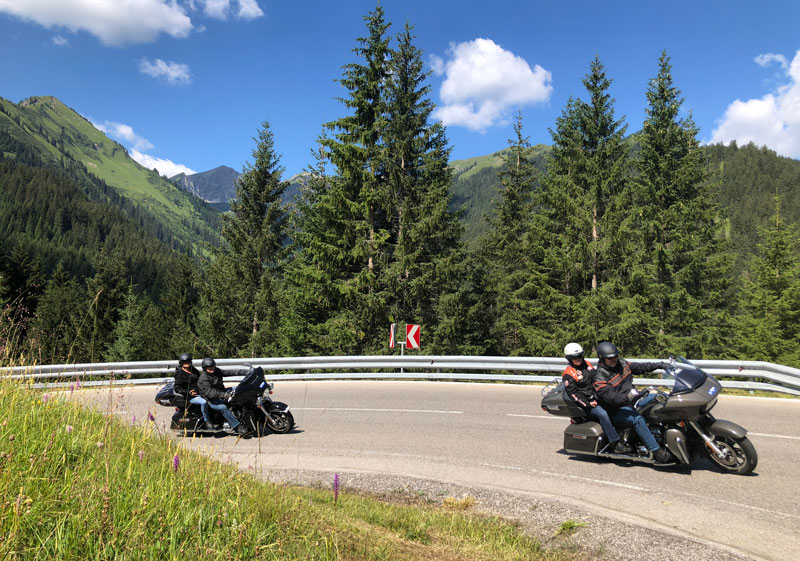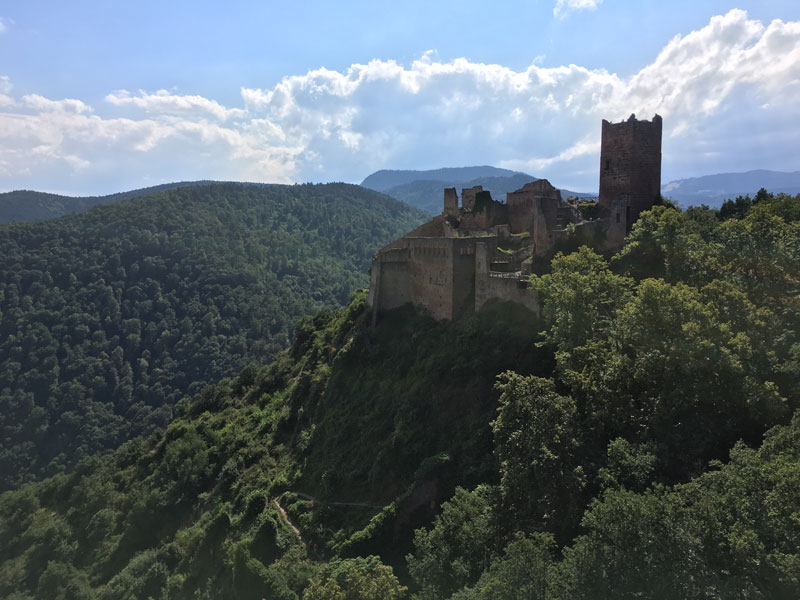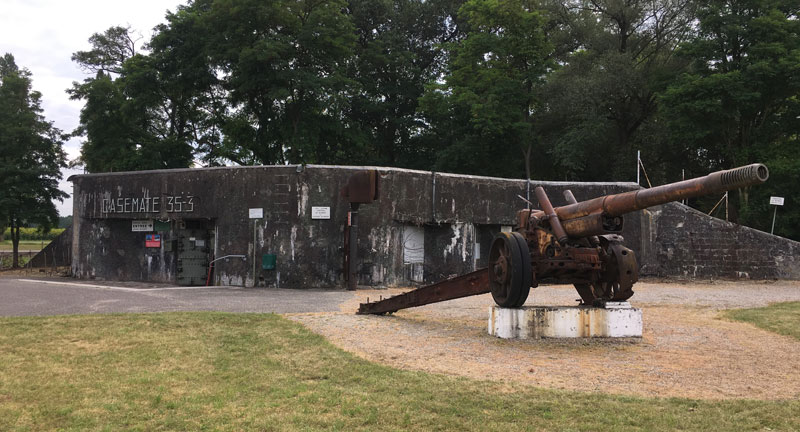Booking your first overseas motorcycle trip can be stressful enough, but that first day in the saddle in an unfamiliar place, on an unfamiliar bike, on unfamiliar roads marked by unfamiliar and probably unintelligible signs, can be a little overwhelming.
Fortunately every single person (with the exception of yours truly) on my recent Edelweiss Best of Europe tour was in the exact same boat, something Ursula, our lead tour guide, didn’t find at all surprising.
According to her, the Best of Europe tour is extremely popular with first-timers, and for good reason. It’s an ideal introduction to what riding in Europe is all about: smooth, not-too-technical roads that allow you to focus on enjoying the quaint villages, spectacular scenery, delicious food, sprinkling of history and castles everywhere you turn.
I recognized it for what it was immediately. This was a gateway drug, what the savvy dealer gives you to get you hooked, probably for life. (Given how many hands went up at our farewell dinner when Ursula asked who would return for another tour, I’d say the hook is firmly planted.)

As for me, the Best of Europe tour was my pick for a variety of reasons, but a large part of the decision might surprise you: genealogy. Genealogy is a hobby of mine and over the years I’ve traced back both sides of my family to some specific areas, including southwestern Germany, Alsace (now a part of France) and Switzerland – all of which we’d be visiting on the tour.
In fact, when pouring over the tour overview and overnight stops in the weeks leading up to the trip, I calculated that at best I might even be able to visit at least two villages where my ancestors were from.
At worst, I come home with an authentic cuckoo clock and an abundance of memories. It was a win-win.

I’m probably preaching to the choir, but if you’re going to visit Europe, doing it on a motorcycle is the way to go – with the possible caveat that you choose the right tool for the job.
European roads tend to be narrower than what we’re used to in the U.S. or Canada, especially in villages and cities where cobblestones and tight turns are common, and they’re rarely straight. For these reasons, I opted for a BMW F 800 GS with its ready-for-anything suspension, lighter weight and nimble handling.

My tour-mates also chose wisely: there were several R 1200 GSs, a couple of R 1200 RTs, and one-up riders on a Triumph Tiger 800, Honda NC700X and BMW R 1200 RS.
Two couples traveling together from Pennsylvania opted for big Harley touring bikes – ideal for wide American roads but, as they learned as the week went on, a bit of a handful on our brief Alpine sections.

The Best of Europe route was thoughtfully designed to incorporate progressively more technical roads, allowing riders to get accustomed to their bikes and the foreign surroundings before hitting the serious twisties on the last few days.
Edelweiss assigns it a difficulty level of 2 out of 5, but remember it’s a European 2; as long as you’re comfortable with low-speed maneuvering and stringing together some curves you’ll have a great time.

Our tour would loop us out of Erding, north of Munich, through undulating farmland and along river-carved valleys west and south to the famous Black Forest, before ducking into France for a rest day.
Refreshed, we’d then head back east into Germany, slip into Switzerland’s impossibly green hills studded with jagged gray peaks, then finish with a day on endless curves in Austria before returning to Erding.

The gently rolling farmland we encountered on our first two days, from Erding to Rothenburg and then on to Heidelberg, reminded me why German immigrants to the U.S. felt so at home in places like Pennsylvania, Ohio, Indiana and Wisconsin.
Well, apart from the castles. They’re everywhere it seems, from 11th century ruins to gilded 18th century monuments to excess. Our first night’s stop was in Rothenburg, a beautifully preserved medieval walled city where we followed a “night watchman” on a twilight tour of the old town, while day two brought a stop at the partially-ruined Hirschhorn castle and a finish in famous Heidelberg with its mammoth palace lording over the city below.

We usually had a couple of free hours each evening between arriving at the hotel and dinner, and by the second night in Heidelberg it was clear I’d need to devote mine to getting some exercise.
German food is serious business, made even more so by the ubiquitous beer served with dinner (I opted for local wines, also very good and far less filling), and if I was going to have any hope of maintaining my girlish figure on my weeklong tour I’d need to do some walking.

When I announced my intention to walk the steep path up to Heidelberg’s palace rather than take the tram, one tour-mate teased me with a quote from “The Princess Bride:” “Have fun storming the castle!”
The joke stuck, and from then on storming castles became a central theme of the trip. There was the trio of ruins guarding the medieval Alsatian town of Ribeauvillé, which I explored on our rest day; the circular 16th century fortress called Munot surrounded by vineyards at the center of Schaffhausen; and King Ludwig II’s ostentatious tribute to his idol Louis XVI, Castle Linderhof, a lunch stop for the group on our last riding day.

Between castles, our Edelweiss guides let us sample just about every type of road found in the heart of Europe, from the limitless Autobahn to meandering country roads to the sinuous switchbacks of the Austrian Alps.
They led us through and to places we’d likely never have found on our own, like the hidden Hexenlochmühle (“mill of the witch place”), where we enjoyed slices of Black Forest cake and peeked into the cuckoo clock workshop.

That said, riders are always encouraged to explore on their own if they so choose – Edelweiss furnishes a detailed map with the daily route highlighted, plus a guide book – so on the rest day in Ribeauvillé several of us decided not to go on the optional group ride into the Vosges Mountains, opting instead to head off on solo adventures.
After breakfast with the group, I hopped on my GS and headed back towards the Rhine River and Germany, my destination a village where my great-great-great grandfather was born.

But first a visit to a piece of world history: the Maginot Line. This series of fortifications and tunnels was built to deter a repeat of Germany’s rapid invasion of France during WWI, and stretched along the French border all the way to Belgium.
Today several Maginot Line structures still exist, and one happened to be just a few kilometers away from Ribeauvillé.
After a sobering walk through the bunker’s chambers and a stroll over the grounds where American vehicles from the liberation force were on display, I headed for my ancestor’s German village.

Many parts of Europe have a complicated history, but this area of modern-day France and Germany seems to have endured more than its share of hardship, from the slaughter and devastation of the Thirty Years’ War (1618-1648) to the confusion and alliance-shifting of the Napoleonic Wars (c.1792-c.1816) to the post-WWII occupation.
As a result, many of America’s German immigrants came from this area, Baden-Württenberg, and the numerous neighboring principalities.

My grandfather’s village sits only a couple of kilometers from the east bank of the Rhine, surrounded by flat fields of golden-tasseled corn and lush green woods; to the east rise the dark hills of the Black Forest. Agrarian but hilly Southern Indiana must’ve felt very familiar to him.
It turned out I was far from alone in my tour group when it came to my German heritage. Several participants mentioned the pleasure they felt in connecting with their roots on our ride.


After our rest day, the riding difficulty was cranked up a notch as we traversed the Black Forest again and entered Switzerland.
Rolling green hills and gentle curves gave way to our first Alpine pass and a lunch break at the mountain Säntis, at 8,200 feet the highest in eastern Switzerland.



 From there, the curves continued non-stop as we crossed into Austria and ascended the famous Hochtannberg Pass (shown in the lead photo).
From there, the curves continued non-stop as we crossed into Austria and ascended the famous Hochtannberg Pass (shown in the lead photo).
By the next morning, our last riding day, the group was salty and ready for anything – a far cry from the slightly nervous, curve-shy bunch many of the riders had started out as.
We’d stormed castles, eaten our weight in spätzle, toasted our somehow perfectly sunny riding days with liters of beer and wine each evening, and scuffed the sides of our tires on roads so pretty it can be hard to keep your eyes on where you’re going.

The Best of Europe tour really is a gateway drug to the joys of motorcycle travel in Europe, a dip of the toe, a sampling of the smorgasbord. Just be warned: you might get addicted.
Best of Europe runs five times in 2019 and 2020, once a month from May to September. For more information visit edelweissbike.com.















Nice write-up, Jenny.
My wife and I took the 1998 version of this BOE trip. Like your fellow travelers, this was our first Edelweiss trip, and we enjoyed it immensely. We chose an R850R, which was the same bike I had purchased the year before (when I go my street-riding license). You can compare and contrast at my web gallery of scanned-in printed photographs (remember those?), at http://billanddot.com/1998-07-Best-of-Europe/ .